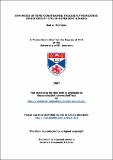Files in this item
Synthesis of ring-constrained thiazolylpyrimidines: inhibitors of cyclin-dependent kinases
Item metadata
| dc.contributor.advisor | Westwood, Nicholas James | |
| dc.contributor.author | McIntyre, Neil A. | |
| dc.coverage.spatial | vii, 177 p. | en |
| dc.date.accessioned | 2007-06-21T09:28:29Z | |
| dc.date.available | 2007-06-21T09:28:29Z | |
| dc.date.issued | 2006 | |
| dc.identifier | uk.bl.ethos.551964 | |
| dc.identifier.uri | https://hdl.handle.net/10023/353 | |
| dc.description.abstract | One current approach in the treatment of cancer is the inhibition of cyclin dependent kinase (CDK) enzymes with small molecules. Here the discovery and development of 2-anilino-4-(thiazol-5-yl)pyrimidine CDK inhibitors is described, including details of the design and successful synthesis of novel ring-constrained thiazolylpyrimidines. The structure-activity relationship (SAR) trends exhibited by this constrained thiazolylpyrimidine family of CDK inhibitors are presented and compared with those from an unconstrained series of analogues. One significant finding from this aspect of the project was that ring-constrained thiazolylpyrimidines in general inhibit CDK2-cyclin E with greater potency than the corresponding unconstrained forms. Furthermore, an X-ray crystal structure of 2-methyl-N-[3-nitrophenyl]-4,5-dihydrothiazolo[4,5-h]quinazolin-8-amine, a representative from the constrained thiazolylpyrimidine series, in complex with CDK2-cyclin A is reported; confirming the binding mode within the CDK2 ATP binding pocket. A further assessment of SARs through the synthesis of control compounds and an extended study into the synthesis of N-substituted derivatives is described. The identification of CDK inhibitors that possess a strong selectivity profile across the CDK family is important. For example, the identification of highly CDK4-selective inhibitors should enable researchers to study the biological role of this important enzyme and to enable a block of cell division in the G1 phase. Here synthetic attempts to prepare a potentially CDK4 selective inhibitor compound, namely 5-methyl-N8-[4-(piperazin-1-yl)phenyl]thiazolo[4,5-h]quinazoline-2,8-diamine, are described. This approach was inspired by SAR data published on a structurally related inhibitor, 8-cyclopentyl-5-methyl-2-[4-(piperazin-1-yl)phenylamino]pyrido[2,3-d]pyrimidin-7(8H)-one. | en |
| dc.format.extent | 2675 bytes | |
| dc.format.mimetype | application/pdf | |
| dc.language.iso | en | en |
| dc.publisher | University of St Andrews | |
| dc.rights | Creative Commons Attribution-NonCommercial-NoDerivs 3.0 Unported | |
| dc.rights.uri | http://creativecommons.org/licenses/by-nc-nd/3.0/ | |
| dc.subject.lcc | QD401.M5 | |
| dc.subject.lcsh | Pyrimidines--Synthesis | en |
| dc.subject.lcsh | Cyclin-dependent kinases--Inhibitors | en |
| dc.subject.lcsh | Cancer--Treatment | en |
| dc.title | Synthesis of ring-constrained thiazolylpyrimidines: inhibitors of cyclin-dependent kinases | en |
| dc.type | Thesis | en |
| dc.type.qualificationlevel | Doctoral | en |
| dc.type.qualificationname | PhD Doctor of Philosophy | en |
| dc.publisher.institution | The University of St Andrews | en |
This item appears in the following Collection(s)
Except where otherwise noted within the work, this item's licence for re-use is described as Creative Commons Attribution-NonCommercial-NoDerivs 3.0 Unported
Items in the St Andrews Research Repository are protected by copyright, with all rights reserved, unless otherwise indicated.


